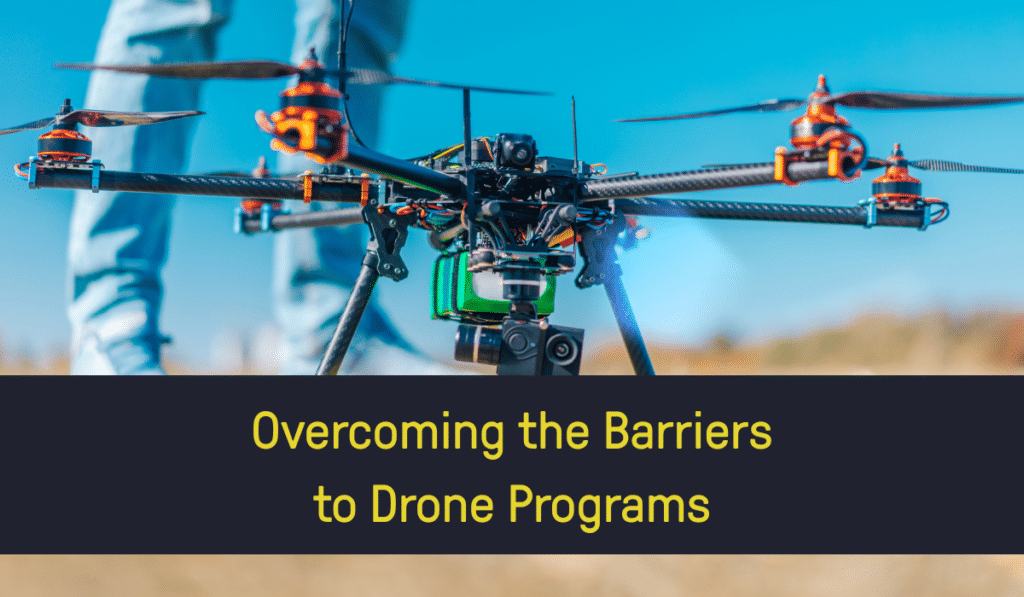Overcoming Internal Opposition to Drones
New technology often receives pushback. So, how can you overcome opposition to drones within your organization?
The start of April 2023 marked the 50th anniversary of the first cell phone call.
On April 3, 1973, Martin Cooper, the head of the communications division at Motorola, made the historic call to, of all people, his competitor at Bell Labs. It was a huge breakthrough, yet many people laughed at the ridiculousness of Motorola’s invention.
Numerous people thought the weight and size of the brick-like device would never replace wired telephones.
After all, who would want to carry a phone when they could easily use their house phone or one of the countless payphones available on nearly every corner?
However, resistance to the technology eventually waned, and now it is a rarity to find someone who doesn’t have one or more of these once laughable devices.
There’s something inherent in our nature to resist change.
Like cell phones, drones were once laughed at or dismissed as toys. However, over the last decade, they’ve become more accepted as their business value becomes realized.
Greater adoption of the technology has been a product of the many benefits drones produce. Drones have proven themselves capable of delivering lower cost, greater efficiencies, improved safety, and decreased labor requirements.
Still, as organizations look to add or grow a drone program, internal resistance often exists.
If you face pushback from within your organization, all is not lost. Several proven methods exist to address and overcome opposition to drones & drone programs.
Communicate the Benefits to Overcome Opposition to Drones
Fearing change is something most people deal with in one form or another.
Often a lack of awareness about why the change is advantageous remains part of this fear. For this reason, explaining the benefits of using UAV technology is one of the most effective responses to those leery of adopting drones into an organization.
Budget-conscious team members will appreciate the cost savings. Project managers, typically under time constraints, can appreciate how drones can complete numerous tasks faster than traditional, manual methods.
Upper management might have concerns over the initial investment until they see improved safety statistics and lower labor costs.
When presenting the benefits, remain realistic.
When trying to overcome opposition to drones, there’s no reason to oversell them; they sell themselves.
Address Concerns
When perceptions or concerns cause friction, they need to be addressed. Start by listening to the concerns.
Once you understand the person’s point of view, build trust by acknowledging their feedback. You can then explain your point of view and ease some of their reservations.
You can see a good example of this in the argument that drones will take jobs away from people.
Some will argue that drones remove people from specific tasks and, in doing so, send someone to get their JSA (formerly UB40) or unemployment compensation.
However, in most cases, you can simply train the people performing that task manually to use incoming UAV technology.
So, instead of replacing people, drones actually add greater value to employees. They also open more jobs in the sector for training, drone repair, data analysis, and more.
Start Small
Don’t set yourself up for failure by overselling. While drones are fantastic tools, like anything else they can’t solve every problem under the sun.
Here, you must separate the promotion of UAV technology from hype. Start small, and work your way from there.
Some companies, such as BNSF, have extensive drone programs. While large fleets have the potential to significantly impact an organization, speaking to the benefits of numerous drones could prove too much to understand for someone resisting the technology.
When trying to overcome opposition to drones, start with one drone and one use case. Be specific and focus on the UAV’s benefits to a single use case.
Set Reasonable Goals and Stay SMART
When met with opposition to drones or drone programs, try countering the response by setting achievable goals for implementing drones into your organization.
Discuss what you would like to see drones bring to your company with other team members. Remain transparent in these discussions, and set reasonable goals for the program.
An excellent strategy for building realistic goals is to implement the SMART method. SMART stands for Specific, Measurable, Achievable, Relevant, and Time-Bound.
Let’s look at one example: adding of a drone to a team inspecting pipelines for gas leaks in the oil and gas industry.
S: Use a drone to detect methane gas leaks faster than a team currently can with handheld scanners.
M: Compare the time the drone takes to complete the task versus historical labor records of the time it takes the team to complete the same task manually.
A: The goal will be completed when we have time comparisons for equivalent periods of work, both with and without the drone.
R: If the drone completes the work in less time, we can prove its value to the team.
T: We will conduct this comparison over the next 30 days.
Through clear, actionable goals, you can produce clear, reliable data.
Bringing It Together
Understandably, some people resist new technology, even platforms as advantageous as drones.
Addressing internal pushback is always the best course of action. By sharing the benefits of using UAVs, addressing concerns, starting small, and setting reasonable goals, you can conquer even the most steadfast opposition to drones.
—
So, are you ready to take advantage of drones for your organization? If so, how do you get started? Do you hire out or bring your drone program in-house?
At Consortiq, we help companies across every industry discover better solutions through the use of drones. We’ll help you create and develop an in-house program from the ground-up, or simply perform the work for you, if you prefer.
Ready to learn more? Just complete the form below to schedule a risk-free consultation!

David Daly - Contributing Author
David Daly, is an award-winning photographer/writer and licensed (FAA) Commercial sUAS pilot. A graduate of the United States Naval Academy, David is a former Marine Corps officer with a BS in Oceanography and has earned his MBA from the University of Redlands. David has worked for Fortune 100 companies and has a background in aerospace, construction, military/defense, real estate, and technology.
Ready to Utilize Drones For Your Organization?
Contact Us Today to Get Started!




